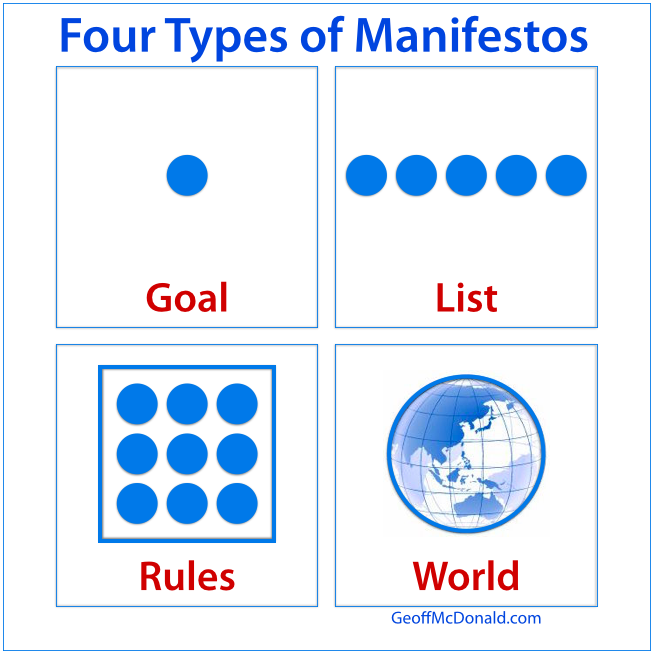What are the four types of manifestos? Knowing this will help you write a manifesto to create your future, and possibly the future of those around you as well.
[Updated and Expanded Dec 2022]
There are four main ways to write a manifesto because there are four types of manifestos. But which one is the best for you? This depends on what you want to create. And it depends on who you want to join in with you to make it happen. If you pick the right one, you’ll gain a lot of motivation and inspiration from it. And if you pick the wrong one, well, maybe you won’t get the result you want.
1 Goal Manifesto
Our first type of manifesto is a goal. And you might be thinking of goals. Is a goal a manifesto? To answer that we can look at the definition of a manifesto. A manifesto is a public declaration of your intent. Your intention is a goal, right? I want to have this, I want to make this happen. That’s a goal.
A goal could be personal. For instance, on New Year’s Eve, you might make a resolution to say I’m going to quit my job, I’m going to lose weight, or I’m going to swim the English Channel.
A goal can also be a community or global intention. One of my favourite examples is JFK sending a man to the moon he required the full attention of the country to pull that off within the decade that he wanted. Or it might be to end poverty, ban nuclear weapons or save endangered species.
If you have a single, strong and clear objective that you want to achieve, then a goal manifesto might be the right one for you.
2 List Manifesto
Our second type of manifesto is a list. Essentially, this is a lot of single goals put together on one agenda.
A popular example of this is a bucket list. These are the things you want to do in your life before you kick the bucket. I interviewed the world expert on Bucket Lists Trav Bell here.
In some countries like Nigeria, the UK and Malaysia, the politicians in the run-up to the election, deliver a manifesto as the list of promises they’re going to deliver on if they’re elected into the parliament.
But not all lists are manifestos. For instance, your shopping list or to-do list, are declarations of your intent to perform certain tasks or buy specific things, but they’re not manifestos because you don’t make them public.
A list manifesto is perfect if you have a series of related goals that you want to accomplish. And a bucket list style is a simple and easy way to create a personal manifesto.
3 Rules-based Manifesto
Our third type of manifesto and a third way to create or write your manifesto is a rules-based manifesto. And it has two parts. First, you’re defining a context, a place or a situation. And the second is how you’re going to behave or act in that situation.
The Archetype
The archetype for our rules-based manifesto comes from The Bible. It’s the 10 commandments. The story goes that Moses met up with God possibly for a beer after work. And God gave him a set of instructions in the form of a stone tablet and said, If you want to be a good Christian, here are the 10 things, the 10 commandments you must follow. So if you want to live true to the Christian faith, which is the context here, then you want to follow the rules of don’t steal, things, don’t kill people, don’t take the Lord’s name in vain, and so forth.
Corporate Values
Lots of corporates use values as a way to describe how they want their employees to behave while working in that organization. That’s a manifesto, even though they probably don’t call it that.
Thought Leadership
And for me, my big use of a rules-based manifesto is when I work with my thought leadership clients to either create their big idea or write a book or create a presentation. The rules-based manifesto sets the context that they’re operating in, whether it’s leadership or sales or marketing. And then they define how you succeed or be successful operating in that area.
A classic example of this is Stephen Covey’s fantastic book, Seven Habits of Highly Effective People. In the domain or the context of being effective, he says, these are the seven things you need to be doing. I talked about the Covey Example in this podcast episode starting at the 33-minute mark.
The big difference between a list manifesto and a rules-based manifesto is that the list is really just a set of outcomes, a set of whats, whereas the rules-based one talks about behaviours, which is the how – how you’re going to act.
If you’re going to define what your goals are, then choose a list manifesto. But if you’re going to define how you’re going to behave or act, then you want a rules-based manifesto.
4 World Manifesto
Our fourth type of manifesto is a world manifesto. And in simple terms, you’re using a manifesto to describe how you want the world to be. It’s a vision for a possible future.
I have a Dream
And my favourite example here is Martin Luther King’s I Have a Dream speech. In that speech, he describes the world he would like to live in – the world he wants to see when there is an end to racism: “That my four little children will one day live in a nation where they will not be judged by the colour of their skin, but by the content of their character. I have a dream today.”
While a world manifesto is a little bit trickier to actually create, it’s way more powerful for complex situations like Martin Luther King’s end to racism. If he’d simply stood up there and said, ‘Let’s stop racism’, (a goal manifesto) no one really would have listened to him. That had already been said plenty of times by plenty of people. And if he offered a list of things to do (a list manifesto) or a set of rules (a rule-based manifesto) we probably wouldn’t be talking about him today either. Instead, in his world manifesto, Dr King paints a picture of how the world could be.
How to write a manifesto
The big lesson to remember here is that everything starts with a manifesto. It starts with you declaring your intention. And it’s remembering that you have the power right here, you have the power in your heart, and in your voice to speak your truth or the world that you want to live in.
And while you might want to change the world, I suggest you start relatively small here. By all means, start with a big goal, but speak to friendly people or supportive people to get their feedback on it before you move forward and share it with a wider audience. In this way, you can grow and refine and develop your manifesto as you share it with more people and get more feedback.
Which manifesto do you need?
Here are my suggestions for which manifesto suit you best:
- Personal – create a single goal or a simple list
- Business Expert or Thought Leader – create a set of rules for others (ideally your clients) to adopt as practices
- An Organisation or Social Enterprise – develop a vision of the world you are working to create.
- Single Goal – if you have a strong and clear single objective then a goal manifesto may be right. You might also add one of the other types of manifestos to boost your motivation and inspiration.
- Outcomes – if you have a list of goals to achieve then a list manifesto is a good choice
- Behaviours – if you want to define how your community should behave, then consider a rules-based manifesto.
Here’s Ten Famous Manifesto – see if you can identify which type of manifesto they are.
More on the Types of Manifestos
If you want more on the types of manifestos and how to write one, consider these three relevant posts and videos:
- Famous Manifestos – The Top Ten of All Time
- How Thought Leaders earn money from what they know
- Thought Leadership Content – What is a Manifesto?
Which type of manifesto are you going to write?




